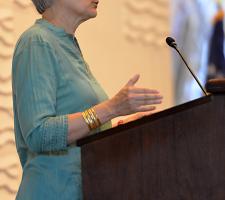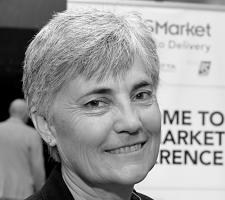
Our urban and suburban spaces could become a heaven or a hell in the near future depending on the way we choose to let new services and technologies evolve.
The convenience of summoning a robotaxi to pick us up or deliver our every consumer whim is the good part. Gridlock and a frantic urban environment as we all seek the same things at the same time, the bad.
We need not even project into the near future to see such problems magnified to unmanageable levels. We are seeing the early signs of both as ride-hailing services and online deliveries grow in popularity. It has already happened in megacities such as Lagos or Mumbai.
Paying a chauffeur to circle the block in the absence of a parking spot or ordering a single item to be delivered by car from a nearby shop is a trifle for the rich in such places. Not so for everyone breathing their fumes or waiting behind them in frustrated queues.
Preventing the worst
The march of technology will simply accelerate these trends so we need to work now to organise urban mobility to prevent the worst from happening, says Robin Chase, co-founder and former CEO of car-sharing business Zipcar, and co-founder of urban mobility data company Veniam.
“We are seeing the rise of technology as an asset and we are also seeing that the value of a car-dominant city has reached its zenith,” says Chase. “The city regulatory and physical infrastructure has been built on a personal car-dominant infrastructure. We have spent the last 100 years making car travel in cities the most convenient and cheapest way to the exclusion of everything else.”
That creates problems, she continues. “Today, mayors and cities are signalling by price that they are indifferent as to whether you take your zero emissions and small footprint bike or a 25 year-old car that pollutes heavily or indeed a shared taxi or public transit. Currently the city is signalling that ‘all those things are the same to us’.”
A shared vision or even much of a conversation at all (between local governments, the private sector, urban planners and academia) about what a better mobility balance looks like has been lacking - until now.
Chase is one of the influencers behind the recently published Shared Mobility Principles (sharedmobilityprinciples.org), developed by a group of non-governmental organisations (NGOs) and adopted by a range of public bodies and mobility players. Their aim is to find some common ground from which to build a more efficient, sustainable and equitable approach to urban mobility, says Chase.
Robin Chase: at a glance
• 2017 Adviser, Advisory Committee for Automated
Transportation, US DoT
• 2014 Board member, Tucows
• 2012 Executive chairman, Venian
• 2009 Named in Time’s 100 Most Influential People
• 2000 Co-founder and CEO, Zipcar
Shared vision
“It is creating a common shared vision between government, the private sector, academia and NGOs of where cities want to go. It stemmed from when I was talking to large private companies and they would say ‘cities don’t tell us what they want and then yell at us when we don’t give them what they need’.”
The shared mobility principles state that transport in cities should be multimodal and should emphasise walking, biking and zero emission shared transport modes. They also exhort cities to make more efficient use of their assets and to focus on moving people, not cars.
The result should be fair pricing of the different mobility options, says Chase. “The point of doing road congestion pricing and kerb access pricing is so we can start getting at fair user fees across all modes. Personal cars are not paying a fair share and because of that we have been responding to the wrong price signals which is why we don’t have enough walking, biking or shared transport modes.”
This will help enable limited road capacity to be more equitably shared via fairer user fees across modes. Such a model recognises the utility that cars will still have rather than simply demonising them or trying to squeeze them out altogether, says Chase.
This leaves space for the likes of Uber, Lyft and Didi to contribute to easing congestion through ride-sharing - especially if this evolves into services with larger, dynamically-routing shuttle buses along the lines being trialled by ventures such as Via (ridewithvia.com), says Chase.
“I see this as a positive development along with all the bike-sharing that is happening now and the rise of more dynamically priced parking. We are also seeing experimentation with charging for pick-ups, drop-offs and delivery at the kerb.”
Mobility options
She does not go as far as Jarrett Walker, who sees mass transit as the only serious answer to mobility at scale in cities (see ITS International, March/April 2018). Chase believes there will be different solutions in different contexts and suggests ride-sharing and bus services may have more of a role in less dense urban and suburban contexts.
Different mobility options are also important for different people at different times, says Chase. The trick is pricing the options appropriately: “We need a suite of modes that reflects different phases in life and different economic phases in our lives. I can still take a car that is a huge benefit into the city in peak times but I am going to pay a lot for that. Public transit, which is doing an incredibly important job, is currently having to compete unfairly against people driving vehicles regardless of size and occupancy. They don’t pay per square metre, based on time of day or based on what comes out of their tailpipe.”
Pricing the use of personal cars should be simple given that they are already registered and the data on their size and likely emissions would be easier for a city authority to gather and factor into pricing, argues Chase: “You would not need any other piece of paper from any other car owner.”
New and emerging technology can help authorities achieve this without the costly, large-scale infrastructure investments involved in projects such as London’s congestion charging zone.
The emerging generation of cameras and other smart sensors able to handle a variety of functions - from traffic enforcement to safety to congestion charging - should give cities the option to adopt more flexible approaches to building out such infrastructure rather than embarking on large-scale procurement projects. “We don’t have to have sole-source, single-purpose procurements any more. The opportunities now are to think about the fine-grained, unbundled ways we can respond to problems,” says Chase.
Use of data
Key to smarter and fairly priced mobility will be the use of data, which will probably be most useful and flexibly applied if it comes from multiple sources, she says. It represents an emerging commercial opportunity for players able to help city authorities to aggregate different data streams.
Chase also sees the smartphone as an as yet under-appreciated asset in helping create smarter transportation options. “Using smartphones to do this pricing for parking, for kerb use or for congestion is incredibly appealing to me just now.”
Another under-appreciated part of the infrastructure necessary to improving mobility lies in data bandwidth and spectrum, says Chase. “Connected vehicles need a connected infrastructure. When upgrading smart traffic or street lamps it is sometimes the case that cities are putting in WiFi or cellular connectivity but typically they are not adding in what is required to do vehicle-to-vehicle communications.”
The required standard for dedicated short-range communications (DSRC), 802.11p, should be being put in place to anticipate needs that are almost upon every large city, says Chase. “We have not connected cars in yet and cellular is 100 times more expensive than the DSRC part of spectrum.”
New projects and new ways of doing things are of course hard to establish and tough to get legislators - and especially citizens - to buy into. The best way to progress innovations is to establish pilots, concludes Chase. “The majority of people think they like the status quo and pilots can make them experience the alternatives. We know the public is willing to engage with pilots. When people experience what it’s like to be in a car-free zone or to experience expanded space for bikes and they see it is more pleasant and that they move faster, they come to like it.”







